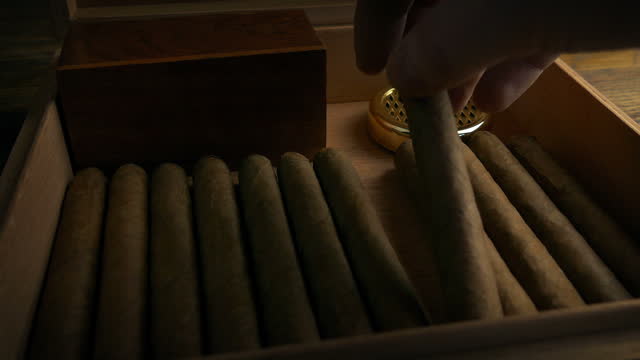Are you a cigar enthusiast looking to get the most out of your cigars? Have you been wondering how often to rotate your cigars in your humidor?
If so, this blog post is for you! This post will discuss the importance of rotating your cigars and provide tips on when and how to do it.

Why Rotating is Important
Understanding humidity and cigar rotating are essential for cigar lovers. Humidity is an important factor in preserving the taste and quality of cigars. Too much or too little humidity can damage the cigars, so it’s important to keep a close eye on the levels.
Rotating your cigars in a humidor is important to ensure consistent access to humidity for all cigars. This is especially important if your humidor is filled close to maximum capacity or has multiple levels and trays.
When cigars are rotated, they get equal exposure to moist air, allowing them to age properly. In addition, regular rotation and flipping of cigars help keep the environment even, preventing any differences in humidity from forming in different areas of the humidor.
Another benefit is that it helps to keep your cigars from becoming damaged or over-humidified. By rotating them regularly, you can prevent them from becoming too dry or damp. Additionally, it also helps to prevent any mold or mildew growth on your cigars. Ultimately, regular rotation of your cigars will help to keep them in top condition for years to come.
How often Should I Rotate My Cigars?
The frequency at which you should rotate your cigars depends on the size of your humidor and the number of cigars stored inside. Generally, for a humidor that is at least 50-70% full, it is recommended to rotate your cigars every 60 days.
If your humidor is only 20% full, a rotation of your cigars, every 1-3 months is sufficient. Rotating your cigars ensures that all the cigars in the box are exposed to the same humidity level and prevents any cigars from developing too much moisture or drying out.
It is also important to check the humidity levels in your humidor with a hygrometer before and after rotating your cigars to ensure that the right humidity level is maintained.
How to Properly Rotate My Cigars
- To properly rotate your cigars, start by bringing the humidor out to an open space with plenty of room.
- Next, separate the cigars that have been in the humidor for a long time from the rest of the collection.
- Then, take time each month to rotate and turn each cigar, so those on the bottom are moved to the top and vice versa.
When it comes to rotating your cigars, a few tips can help you ensure they are always stored properly.
Make sure to check the humidity in your humidor regularly; if it is too low, add more moisture.
Additionally, keeping aging cigars separated from others during rotation is important. By following these steps, you can ensure that your cigars can access consistent humidity levels and even aging.
What are the Most Common Mistakes with Rotation?
One of the most common mistakes is failing to rotate your cigars regularly. Ignoring cigar rotation can lead to uneven humidification and dry spots in your humidor, making it difficult to maintain optimal humidity levels.
Another mistake is over-rotating cigars, which can cause the wrapper to crack if done too frequently.
Additionally, not paying attention to the orientation of your cigars when rotating them can lead to uneven storage and make it difficult for you to find the right cigar when needed.
To prevent these mistakes, it’s important to practice regular rotation and keep track of which cigars were placed in which spots to ensure they’re always properly oriented.
How to Tell if You Need to Rotate Your Cigars
It’s important to know when it’s time to rotate your cigars in the humidor so that you can keep them in the best condition possible. You should look out for a few signs that indicate it’s time to rotate your cigars.
If you notice that your cigars have varied moisture levels, or if some are too dry and some are too wet, you should rotate them. You should also pay attention to any spots of mold or discoloration on the cigar wrapper, as this can also indicate that rotation is needed.
Additionally, if there is an unusual amount of dust or debris on your cigars, this can signal a lack of air circulation and warrant rotation.
Lastly, if your cigars appear unusually stiff or brittle, this could indicate that they need to be rotated in the humidor. Knowing these signs will help ensure your cigars stay fresh and flavorful for as long as possible.
Conclusion
In conclusion, it is important to rotate your cigars to get consistent humidity access. Rotation is especially important in humidors filled close to maximum capacity and in large humidors with trays. It is recommended to rotate your cigars every 1-3 months and check them periodically.
Properly seasoning a humidor is also essential for the cigars stored in it. Lastly, avoiding too much humidity or dryness in the humidor is important, as this can lead to cigars drying out or rotting. These tips ensure that your cigars stay fresh and flavorful for as long as possible.

jay
Self proclaimed cigar expert. I've been smoking since 2010. I've practically lived at a cigar lounge from 10am to 10pm and trying every new cigar that came out for years.

